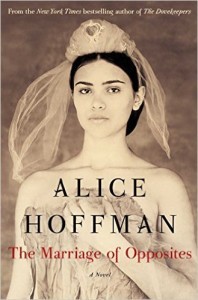If you like detailed historical fiction and a strong female protagonist, then Alice Hoffman’s newest novel should be high on your list. The Marriage of Opposites revolves around the circumstances that brought the Impressionist painter, Camille Pissarro, into the art world, but the main character through a majority of the story is Pissarro’s mother, Rachel Pomie Petit Pizzarro.
Hoffman uses facts about the real Rachel Pomie to recreate a time and place that I’ve never read about in a novel. The book opens in the early 1800s in a town named Charlotte Amalie on the Caribbean island of St. Thomas where Rachel is a child of a tight-knit Jewish community, the members of which can all trace their ancestors to survivors of the Inquisition.
The lushness of Charlotte Amalie and the characters who inhabit Rachel’s life all take on Hoffman’s trademark magical realistic qualities even though the general events are rooted in facts. We meet Rachel as a child who reads and studies as much as she can and dreams of seeing Paris where her family does some business. Rachel’s mother disapproves of her inability to play the role of good daughter and ideal community member. Rachel does, however, agree to marry the widower 30 years her senior who her family chooses because it will help their business survive.
We see Rachel make peace with the ghost of her predecessor as she becomes the step mother to several children and the mother to children of her own. Rachel is 30 when she is widowed and that is when the true love story of the novel begins. When her deceased husband’s nephew arrives from Paris to oversee the business that he, as the next male relative, has inherited, he is drawn to Rachel. While there are several scandalous interracial affairs mentioned throughout the book, the issue keeping Rachel and Frederick apart is not about race, rather, it is their technical status as family even though they are not related by blood. The way their relationship challenges the community around them, especially Rachel’s children as well as the children she and Frederick have together, is what pushes the next part of the book forward. One son of their union is Jacob Camille Pizzarro, who later changes his name to Camille Pissarro.
Several other characters get turns narrating events, including Frederick and Camille.
There is an essential plot point centering on Rachel’s sister-like best friend, Jestine and Jestine’s daughter. We also come to know a variety of characters in St. Thomas and Paris. Most interestingly, we see Rachel through her son’s eyes and the picture he paints for the reader is not nearly as complimentary or nuanced as what we get when Rachel narrates her own story. It’s a good reminder that the point of view we receive in fiction and in real life is always filtered through the mindset and experiences of the person telling the story.
If you like novels about history, love, friendship, art, business, community, and the complications of family, then I highly recommend The Marriage of Opposites.
Latest posts by Nina Badzin (see all)
- #149 – June Friendship Challenge: Ask a Friend For a Favor - June 1, 2025
- #148 – Tricky Friendship Etiquette for the Modern Age - May 26, 2025
- Dear Nina on NPR - May 24, 2025
- #147 – Share Good News With Your Friends - May 20, 2025


